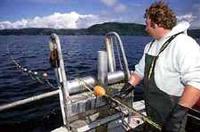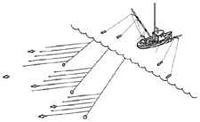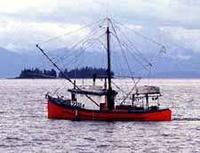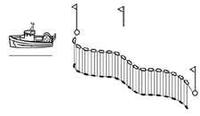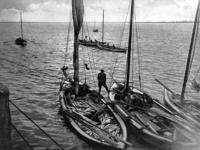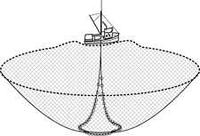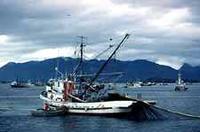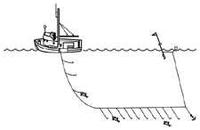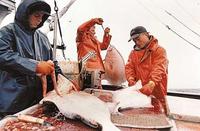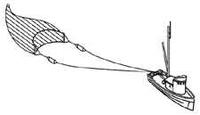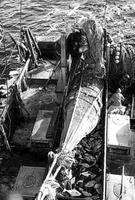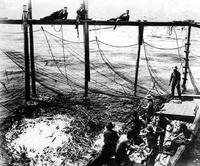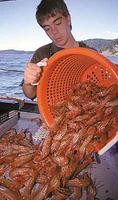Fishing, Commercial
FISHING, COMMERCIAL, in BC dates back to the FUR TRADE era of the early 19th century, when the HBC began buying SALMON from FIRST NATIONS people to feed its employees and for export. The fishery expanded dramatically when SALMON CANNING began at the mouth of the FRASER R in the early 1870s and near the mouth of the SKEENA R shortly afterwards. Gillnetting (see below) was the primary salmon fishing method at this early stage, when the commercial fishery was almost exclusively a salmon fishery. Until the 1920s salmon accounted for two-thirds of the dollar value of the industry. HALIBUT was next in importance, followed by HERRING and COD. A SARDINE (pilchard) fishery flourished between 1925 and 1946. Over 80 different species of fin fish, shellfish and aquatic plants are harvested commercially in BC. In 2003, 304,000 tonnes of seafood products from wild and farmed sources were harvested, with a wholesale value of over $668 million. Seafood is the province's number one food export, with an export value of $997 million in 2003, when it accounted for 25% of the total value of all seafood exports from Canada. Despite its historic importance, the commercial fishery accounts for less than 1% of the provincial gross domestic product. Nonetheless, many coastal communities rely on the fishery for their livelihood and they are being seriously threatened by its decline.
Between 1996 and 2000, the number of salmon licences was reduced by 50%, largely due to government licence buyback schemes (see FISHERIES POLICY). Wild salmon harvests declined as well. The 1999 harvest of 17,000 tonnes was the lowest in 50 years. This was due in part to the severe curtailment of BC's salmon harvest in order to protect and conserve salmon stocks, but it was back up to 38,000 tonnes by 2003. BC's share of the world market for salmon amounted to less than 4% in 1998. Competition has come in recent years from Russia, Japan, Alaska and farmed salmon. By 2003, BC's farmed salmon industry produced 72,000 tonnes of salmon with a wholesale value of $255.8 million, far exceeding the wild salmon harvest (see AQUACULTURE, FIN FISH). Declining yields in wild species have caused fishers to become more and more concerned about interception of Canadian-origin salmon in US fisheries and has touched off several confrontatons with the US (see PACIFIC SALMON TREATY). Meanwhile, federal government policy was aimed at reducing the catch of the fleet by reducing the number of fishing vessels. Other threats to the industry during the decade included the rising temperature of the Pacific Ocean and continued habitat destruction along rivers and streams.
Six gear types are used in commercial fishing in BC: seine, gillnet, hook and line (including longline, troll and jigging), trawl, trap and dive (see DIVE FISHERIES). The major fishing gears for Pacific salmon are seine, gillnet and troll. There are several methods for capturing herring, including seining, gillnetting and ponding. A variety of gear is employed in the shellfish harvest. Hand tools are used in the intertidal zone to gather CLAMS, OYSTERS and goose BARNACLES. Traps are used to land CRAB and some SHRIMP species, especially prawns. Shrimp are also harvested by beam trawls and otter trawls. Small trawl fisheries take place for EUPHAUSIIDS, or krill, and for pink swimming SCALLOPS. Many shellfish species are harvested by divers, including GEODUCKS and horse clams, SEA URCHINS, SEA CUCUMBERS, scallops, OCTOPUS and, before the fishery was closed, ABALONE.
Trolling
Trolling is a salmon fishing method in which fish are caught on hooks towed on lines behind the vessel. The first commercial trolling in BC was done by aboriginal people fishing from dugout CANOES using baited barbs and handlines. European immigrants became involved in commercial handlining from rowboats and skiffs in the 1910s, and the handline fishery remained viable into the 1940s. Gasoline-powered boats were introduced in the early 1900s. The gas boat had tall trolling poles, spread open at the top to form a V, so that multiple lines could run through the water without tangling. the gas boat could be crewed by a single fisher. In about 1912 the gurdy (powered reel) was introduced, eliminating the need for hand-hauling. In the 1930s fishers began to take ice aboard, allowing them to work farther offshore and to stay out for several days; many of them took a crew member to help. By the 1960s, compact freezing systems allowed trollers to freeze their catch at sea, extending their trips even further. In the 1950s and 1960s, the BC troll fleet consisted of approximately 1,600 vessels. By the year 2005, largely due to government buyback programs, the fleet had shrunk to about 500 boats. Conservation concerns for coho, chinook and sockeye stocks have severely curtailed the troll fishery. Modern trolling vessels can have as many as 120 lures in the water at once, at depths of 10 to 60 fathoms. Troll-caught salmon bring in top prices because they are cleaned and iced or frozen immediately after being caught and are not scarred by net marks.
Gillnetting
Gillnetting is one of the oldest forms of fishing, practised around the world for thousands of years. A gillnet is a long, horizontal mesh sheet with floats along the upper edge. It is set perpendicular to the path of the fish and designed so that incoming fish can get their heads but not their bodies through the mesh; thus the term gillnet. First Nations fishers used gillnets made of nettles, CEDAR and sometimes hemp with wood floats and stone weights. In BC waters, gillnets are used primarily in the commercial salmon fishery, but also in the herring roe, EULACHON and recreational SMELT fisheries. Most gillnets are set on the surface but they can be set on the seabed or at any depth in between. A form of gillnet known as a setnet is set from shore. Setnets are most commonly used by First Nations fishers along the banks of major salmon rivers. In shallow inshore waters and small rivers, gillnets are often worked by hand: crew members wade in the water or work from canoes and small skiffs. In deeper waters and in large rivers, gillnets are operated from larger vessels, typically 10 to 13 m long. A typical large gillnetter has the net stored on a hydraulic drum on the afterdeck, and the net is set and retrieved over the stern. Fish are picked out of the net as it comes aboard. Another type of gillnetter is the bow-picker, in which the drum and rollers are at the forward end of the vessel and the net is set from the bow while the vessel backs away. The size of the netting used in a gillnet is determined by the type of fish targeted. Typical mesh sizes include 50 mm for herring, 100–175 mm for cod and 130 mm for salmon. Gillnets vary dramatically in size; an individual net may span 30 to 75 m.
BC's commercial salmon gillnet fishery began on the Fraser R in about 1865 to supply the many canneries that were being built near the mouth of the river. The typical gillnet vessel of the late 1800s was open, double-ended and 6–9 m long. Many had gaff rigs for sailing. The gillnetter was crewed by 2 people: one rowed while the other set and retrieved the net. Nets were made of linen and measured up to 200 fathoms long, and hauling them in was backbreaking work. The gillnet fishery expanded upcoast as canneries were built on the Skeena and NASS rivers, along RIVERS INLET and many other locations. Most early gillnet skiffs were owned by the canneries and rented daily to fishers. By 1900 there were approximately 3,700 gillnet boats in BC, most of them crewed by JAPANESE fishers. Gas engines were in widespread use on the lower coast by the 1910s and fishers began adding small cabins as protection from the elements. This was when the rounded, classic "west coast" cabin with vertical tongue-and-groove planking became common.
In the early 1930s, Laurie JARVIS, a SOINTULA fisher, pioneered the powered gillnet drum. After the war, high-speed 6-cylinder motors were available and speedier boats were able to fish over a wider area. In the 1950s synthetic net materials were introduced and nets became stronger, more durable and more elastic. During the 1970s and 1980s, fibreglass and aluminum vessels became common. Limited entry programs began to be introduced in the 1980s, a measure designed to control the number of boats in the industry. New vessels had to be built to an equal or lesser length than boats they replaced. To build more room into the same length of vessel, the bowpicker was introduced from the US. A vessel of this design had crew accommodations over the engine and left the forward half of the vessel for the drum and storage. This allowed for the installation of larger, faster engines, and wide, roomy accommodations aft. Many of these vessels travelled at speeds up to 40 knots, which meant they could travel almost the entire coast in a day, fishing more openings and moving quickly to areas where fish were most plentiful. In the early 1990s, when a dramatic decline in fish stocks reduced the number of legal fishing days, many people were forced to leave the industry. By the end of the decade gillnetting was tightly regulated; fishers were restricted to specific fishing zones and opening times in an effort to conserve the remaining fish. Between 1996 and 2000, the coastal gillnet fleet was reduced through government buyback programs from 2,269 vessels to 1,411.
Seining
Seining is a method of fishing in which a net is used to encircle fish. Two types of seines are used in BC: the purse seine and the drag, or beach, seine.
The earliest seines were the drag type. Up to 200 m long, they were set from the shore, usually at a river mouth, in a large circle around schooling fish. The net was then dragged ashore full of fish. In the early 1900s, only First Nations people, sometimes working in conjunction with nearby canneries, were allowed to use drag seines. Government policy eventually eliminated most drag seine operations, and the harvest transferred to the purse seine fishery. Drag seining is still being used in the eulachon fishery, as an experimental selective fishing method and as a way to collect brood stock for salmon hatcheries.
A purse seine is designed so that rings, bridles and a purse line are used to gather ("purse") a net along its bottom edge, forming a pouch in which the fish are trapped until they can be hauled aboard. Purse seines are set and retrieved from seine boats, or seiners. Purse seining was introduced to BC from the US in the early 1900s. Early purse seines were set using a pair of rowed boats, the crew of each boat holding half the net. When a school of fish was detected, the 2 boats encircled it in a pincer movement and the net was hand-pursed. Another method, using skiffs and small scows with manual winches, was perfected by the Japanese Canadian fishers who carried on a WWI-era herring seine fishery in GEORGIA STRAIT. With the introduction of the gas engine in about 1905, the setting and pursing operations were brought together on a single, larger vessel. The typical seiner was about 15 m long with a graceful-looking shape. The first of these was built in BC in 1913; by 1920 the purse seiner had become a major force in the coastal fishery, not only for salmon (usually chum, pink and sockeye) and herring, but in the new SARDINE fishery as well. They set and retrieved their nets using a system known as table seining. The net was set from a large, square platform in the stern called a turntable. A small skiff known as a tow-off boat was tied to one end of the net and was used to help pull the net off the stern as the seiner moved away. The seiner then turned in a circle, gradually drawing the net around the fish. The table was turned 90° and the net was pursed and retrieved manually from the side. The skiff also played an important role in towing the seiner sideways so that it did not pull itself into the body of the net as it pursed. The body of the net was hauled aboard by tying a line around a portion of the web and winching it with a line running from the deck winch through a pulley at the masthead.
Early purse seine nets were made of cotton, with different mesh sizes depending on which species of salmon the seiner was catching. The top edge of the net—the corkline—was hung with floats. The bottom edge of the net—the lead line—was made of manila and weighted with lead. Hanging from the lead line were bridles and heavy rings through which ran the purse line. An average seine was 200 fathoms in length and about 15 m deep, large enough to capture 20,000 or more salmon (close to 70 tonnes) in one set. The advent of synthetic fibres led to nets that were lighter, stronger, more durable and easier to maintain. A series of technological innovations greatly improved the productivity of the seine fishery following WWII. The seine drum was introduced in the 1950s, allowing the net to be wound on and off the vessel more easily than with a table. In 1953 the Puretic power block was introduced. This was a hydraulically powered block mounted high above the deck with which the crew could bring the net aboard. During the following decade, tow-off skiffs were replaced by motorized "power" skiffs, where allowed by regulation. In the 1960s wood hulls began to give way to fibreglass and metal hulls. Concerns about overcapacity of the fleet led the government to limit the number of seine licences beginning in the 1970s. New regulations also prohibited licence holders from building new vessels larger than the boats they were replacing, a restriction that led to significant design changes. As with gillnetters, new seine vessels were much wider, often with blunt noses, allowing a dramatic increase in the carrying capacity while staying within length requirements.
Between 1996 and the year 2000, the number of salmon seine licences on the coast was reduced from 536 to 276, largely due to government licence buyback schemes designed to reduce the fish-catching capacity of the seine sector of the commercial salmon fishery. At the same time, Pacific sardine stocks rebounded and a fishery for this species was once again undertaken by seiners.
Longlining
Longlining is a hook-and-line fishery in which long lengths of baited hooks are laid on the ocean floor to catch halibut, SABLEFISH, ROCKFISH, DOGFISH and other species of GROUNDFISH. To set longline gear, a buoy topped with a marker flag is tossed overboard. Attached to it is a length of line (buoy line) at least as long as the depth of water into which the gear is being set. When enough line has been set out, an anchor is tied onto the buoy line, a skate (or fixed length) of groundline is secured to the anchor and the groundline begins running over the stern. At set intervals along the groundline, baited hooks are attached by shorter lengths of line—a metre or so—known as gangions. These are either tied to the longline or attached by removable snap-hooks. Several skates are usually joined together. When enough line has been set out, another anchor and buoy are attached, making a "string" of gear. Further strings are set out as required. Gear is allowed to "soak" several hours, or sometimes all night, before being hauled back aboard. To retrieve the gear, modern longliners use a powered davit mounted amidships. As the boat steams along the track of the gear, fish are gaffed aboard while the longline is spooled back onto a revolving drum or carefully coiled into piles on deck. A typical longline trip lasts 4–8 days, with the fish cleaned and iced at sea to preserve freshness.
Until the late 1980s, longline fisheries were known as a derby-style fisheries. A certain portion of the coast was opened by fisheries officials for a set length of time. Longline vessels then crowded together for the best areas and crews scrambled to fish as much gear as they could to maximize their catch before the fishery closed. Vessels fished regardless of weather, and prices were often low because markets were flooded at the close of the fishery. In the late 1980s, management of the halibut and sablefish fisheries changed to a quota system, where the annual quota is divided among the licence holders and each may fish at almost any time of the year until his quota is met.
Trawling
Trawling, or dragging, is a commercial fishing method in which a trawl vessel (trawler or dragger) drags a cone-shaped net with a rectangular opening through the water to trap fish. Trawling is used to take a wide variety of species in a number of separate fisheries including shrimp, euphausiids, scallops and groundfish. Tthe trawl fishery is the largest commercial fishery, by volume, in BC.
Two types of trawling systems are used, the otter trawl and the beam trawl. The otter trawl is the standard method for harvesting groundfish, while the beam trawl is used primarily in the shrimp fishery. The otter trawl was introduced to BC in about 1910 and is used for both bottom trawling and mid-water trawling (fishing off the sea bottom). The bottom trawl has rollers along its bottom edge, while floats on the top edge keep the net open. The wings of the net are spread by large wood or steel "otter boards," or "doors," which are connected to the winch drum on the vessel and keep the doors straining outwards from the wings. Mid-water trawls do not require rollers because they do not come into contact with the bottom, but they do use weights, floats and doors to keep the net open. Mid-water trawling accounts for more than 76% of the groundfish catch by volume, mostly hake and turbot. Otter trawl fishers estimate that only 6% of the coastal waters of BC are suitable for bottom trawling. This is due to the abundance of underwater obstacles such as pinnacles, rocks and steeply sloped bottoms that cannot be fished. With either net, the trapped fish accumulate in the narrow end of the cone, known as the cod end, which is the last part of the net hauled aboard. The crew then release a special knot at the cod end, the chain knot, and the fish spill out. Otter trawlers are sturdy, powerful vessels, 10.5 m to 45 m long; many of them are constructed from steel. The introduction of depth sounders, synthetic nets and the powered net drum in the 1950s have been the major innovations in the fishery. Since 1997 the groundfish trawl fishery (excluding shrimp) has been managed on an individual vessel quota system for each species. Most groundfish trawlers must carry government-approved observers to gather data needed to manage the fishery and comply with regulations.
The beam trawling vessel is 9 to 13.5 m long, smaller than the otter trawler. The 2 are similar in shape and function but the beam system does not incorporate doors. Instead the wings and mouth of the net are held open by a long pole, or beam, about the same length as the vessel. A beam trawl net does not have rollers. In 2000, there were 200 vessels actively fishing for shrimp using this method. Beam trawlers estimate that only 2% of the BC ocean bottom is suitable for beam trawling.
Both beam and otter trawling raise concerns about bycatch: unwanted species, undersize species or incidental species that the trawler is not allowed to keep. Experimental projects have been underway for many years to reduce bycatch. There is also concern about the ecological effects of trawl nets dragging along the ocean bottom.
Weirs and traps
Weirs and traps are devices that were employed traditionally by First Nations fishers to catch salmon and trout migrating through tidal waters or travelling upstream to spawn. A weir is a fence-like structure constructed from rocks and/or posts and latticework set across a stream to block the passage of fish. Rock weirs at river mouths allowed fish to pass over the barrier on the incoming tide, then become stranded when the tide receded. A stake weir was built across a creek, blocking the passage of the fish, which were speared or netted as they bunched up against the barrier. Some stake weirs incorporated fish traps. The fish passed through a single opening in the weir and into the trap—a device constructed from wood that allowed the fish to swim in but not out. In the late 1800s, cannery owners began constructing large commercial fish traps up to 1 km long. These were located in salt water in areas where major migratory routes of salmon passed close to shore; eg, at SOOKE and BOUNDARY BAY. Such a trap consisted of a row of pilings strung with net, set perpendicular to the shoreline and designed to lead fish into a series of compartments; the last of these was a "spiller," where the fish were trapped. When enough fish accumulated, they were hauled from the trap spiller into scows and towed to a cannery for processing. This type of trap was extremely profitable to the canneries. At one point there were 21 such traps in the Boundary Bay–POINT ROBERTS area (19 were American). During the 1940s and 1950s traps became less and less viable due to restrictive opening times, competition from seiners and rising costs of operation. The trap nets at Sooke, the last remaining device of this sort, closed after the 1958 season.
However, small-scale weirs and traps were again being used and tested in the 1990s as a live capture method, allowing the release of non-target species as part of a more selective and responsible fishery. These methods can also be used to enumerate fish and to collect brood stock for salmonid enhancement.
Small, portable box-type traps have been used throughout the world for thousands of years. In BC they are used to catch shellfish in both the sport and commercial fisheries, usually for crab and shrimp. The commercial fishery also uses traps to catch sablefish. Most traps are a rectangular or circular box shape with a metal frame covered with mesh. Some form of bait is placed within the net. When set, the trap sits on the ocean bottom with a line and a float running to the surface. Prey are drawn by the smell of the food and enter through funnel-shaped openings in the trap. Once inside, they are unable to find the narrow opening again and become trapped.
Selective fishing
The catch of non-target (and sometimes threatened) stocks is a characteristic of most mixed-stock fisheries, particularly those that pursue salmon, groundfish and shellfish. Compounding the problem is uncertain environmental conditions that are causing unpredictable stock abundance and making it extremely difficult to predict the composition and size of fish stocks. Therefore, the ability of fishers to fish selectively by avoiding non-target species and stocks, or releasing them unharmed, is increasingly important. Selective fishing is also seen as part of a long-term conservation strategy for rebuilding the resource. Selective fishing allows fishers to continue to harvest more abundant stocks while protecting weaker ones.
Selective fishing strategies include: minimizing encounters with stocks of concern, experimenting with alternative fishing gear, modifying existing fishing gear, employing new fishing methods, and improving existing gear and practices that reduce fish mortality and injury when releasing fish. Some of the experimental gear and methods that have shown promise are brailing and sorting techniques, revival tanks, fish wheels, traps, weirs and nets, weedlines, tooth tangle nets, Alaska twist web, hot picking, different mesh sizes, and proper catch and release and fish handling techniques. In 1998 Fisheries and Oceans Canada introduced selective fishing as a fundamental and permanent change to the way commercial fishing is carried out in BC.
by Peter A. Robson
Reading: Alan Haig-Brown, Fishing for a Living, 1993; Mark Hume, The Mystery of the Adams River Sockeye, 1994; Peter Robson and Michael Skog, eds, Working the Tides: A Portrait of Canada's West Coast Fishery, 1996.

